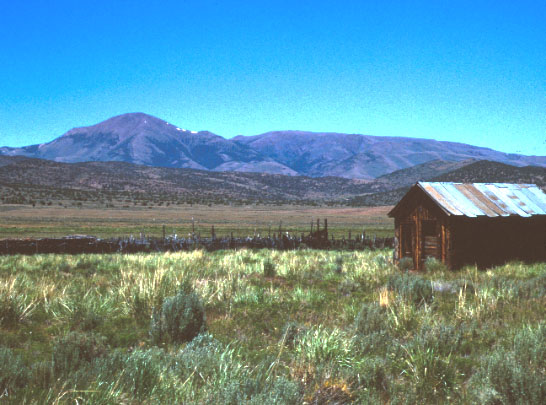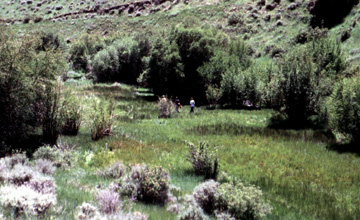Surface-Subsurface Flow Interactions In Riparian Wetlands Of Central Nevada

Stream
Restoration Projects
Sediment
Generation|Surface-Subsurface
Flow Interactions, Nevada|
Anthropogenic and Natural Disturbances
on River Systems, Central Nevada
Sediment Generation and Transport
Principle Investigators
Jerry
R. Miller, Department
of Geosciences & Natural Resources Management, WCU, (Geomorphology)
Mark
Lord, Department
of Geosciences & Natural Resources Management, WCU, (Hydrology; Geomorphology)
David Jewett, U.S.
EPA, National Risk Management Research Laboratory, Ada, OK (Hydrology)
Jeanne C. Chambers, USFS
Rocky Mountain Research Station, Reno (Ecology)

Funding
-
USDA Forest Service Rocky Mountain Research Station
-
USDA Forest Service, Stream Technology Center
Project Overview
Water has always played a critical role in the growth and development of the western U.S. However, the extraction of water resources from streams and rivers for private, industrial, and municiple use has placed many riparian ecosystems that they support at risk. In fact, many riparian ecosystems have been severely degraded due to decreased or altered instream flows resulting from the construction of dams and diversion systems or the extraction of shallow groundwater resources. The potential impact of early dam and diversion projects were rarely assessed, in part, because they were critical to continued population growth, but also because the impacts on riparian ecosystems, and the ecological and sociological services that these ecosystems supply, were poorly understood. While there has been increased recognition of the importance of sustaining riparian habitats, there is still a notable lack of information on the relationships between the nature and magnitude of instream flows and the structure and function of riparian ecosytems associated with western streams. It is, however, becoming increasingly clear that close linkages occur between the depth to the water table and the nature of the riparian plant communities (Allen-Diaz, 1990; Weixelman et al., 1996) and soil types. Decreases in water tables may result in increased plant stress (Smith et al., 1991), decreased plant recruitment (Stromberg and Tiller, 1996), and changes in overall species composition. Although these previous studies demonstrate the general importance of maintaining stream flows, data concerning instream flow requirements necessary to support riparian vegetation is currently inadequate. This is particularly true for streams and rivers that are currently undergoing significant adjustments in process and form, such as channel bed degradation. These data are critical to the sound management and restoration of these ecosystems.
In 1997 we began work on a project to document the relationships between instream flows and the structure and function of riparian ecosystems, particularly with regards to riparian wetlands (meadow complexes) which are located upvalley of alluvial fans that have built away from the valley sides and that extend almost completely across the valley floor. The streams within these basins are incising, and there is concern over the consequences of entrenchment on the shallow groundwater flow system and the associated riparian ecosystems. To answer these questions, we are documenting the interaction between the surface- and groundwater flow systems, the nature of the riparian plant communities, and the variations in plant types with regards to water table depth and depth to saturation.
Our analysis is currently focusing on three meadow complexes; one is located in Big Creek within the Toiyabe Range, one Corral Canyon within the Toquima Range, and the last within Indian Valley at the head of the Reese River. With regards to hydrologic analyses, we have installed more than 60 piezometers and monitoring wells at each site to characterize the shallow groundwater flow system, and have instrumented the associated streams with continuous water stage recorders. These data will be combined with an understanding the site geomorphology and stratigraphy to develop both conceptual and numerical models of the surface- and groundwater flow systems. These models can subsequently be used as a tool to gain insights into the possible responses of the groundwater system and, thus, the riparian plant communities, during channel entrenchment or following the removal of instream flows.
References Cited Above
Allen-Diaz, B.H., 1991. Water table and plant species relationships in Sierra Nevada meadows. Am. Midl. Nat., 126: 30-43.
Smith, S.D., Wellington, A.B., Nachlinger, J.L., and Fox, C.A., 1991. Functional responses of riparian vegetation to streamflow diversion in eastern Sierra Nevada. Ecol. Appl., 1: 89-97.
Stromberg, J.C. and Tiller, R., 1996. Effects of grounwater decline on riparian zone vegetation of semiarid regions: The San Pedro, Arizona. Ecol. Appl., 6: 113-131.
Weixelman, D.A., Zamudio, D.C., and Zamudio, K.A., 1996. Central Nevada riparian field guide. USDA Forest Service, Intermountain Region R4-ECOL-96-01.